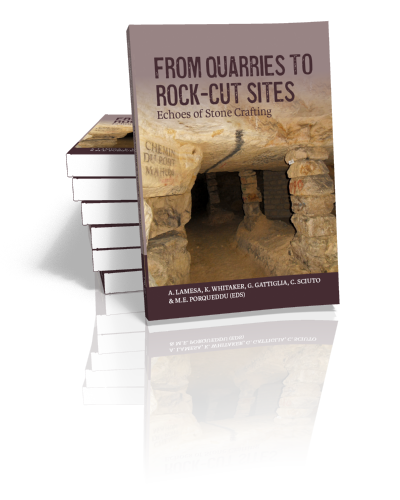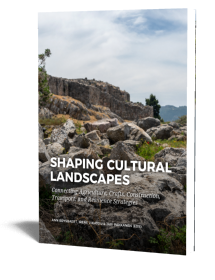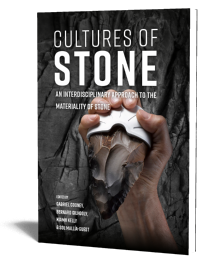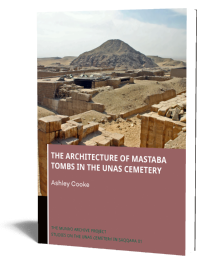From Quarries to Rock-cut Sites
Echoes of Stone Crafting
Edited by A. Lamesa, K. Whitaker, G. Gattiglia, C. Sciuto & M.E. Porqueddu | 2023

From Quarries to Rock-cut Sites
Echoes of Stone Crafting
Edited by A. Lamesa, K. Whitaker, G. Gattiglia, C. Sciuto & M.E. Porqueddu | 2023
Paperback ISBN: 9789464261646 | Hardback ISBN: 9789464261653 | Imprint: Sidestone Press | Format: 173x253mm | 276 pp. | Language: English | 47 illus. (bw) | 61 illus. (fc) | Keywords: rock-cut sites; quarries; hypogea; prehistory; antiquity; Middle Ages; modern times; contemporary times; archaeology; history | download cover | DOI: 10.59641/lbg20ace
Read online 672 times
- Digital & Online access
-
Buy via Sidestone (EU & UK)
-
Buy via our Distributors (WORLD)
For non-EU or UK destinations you can buy our books via our international distributors. Although prices may vary this will ensure speedy delivery and reduction in shipping costs or import tax. But you can also order with us directly via the module above.
UK international distributor
USA international distributor
-
Bookinfo
Paperback ISBN: 9789464261646 | Hardback ISBN: 9789464261653 | Imprint: Sidestone Press | Format: 173x253mm | 276 pp. | Language: English | 47 illus. (bw) | 61 illus. (fc) | Keywords: rock-cut sites; quarries; hypogea; prehistory; antiquity; Middle Ages; modern times; contemporary times; archaeology; history | download cover | DOI: 10.59641/lbg20ace
Read online 672 times

We will plant a tree for each order containing a paperback or hardback book via OneTreePlanted.org.
The archaeological study of quarries focuses mainly on the reconstruction of the extraction process, while rock-hewn spaces have often been approached from the point of view of architectural styles or art-history. Nevertheless, a holistic structural approach to the study of these spaces could allow a better understanding of the agency of those who carved the stone.
Stone quarries and rock-cut sites have rarely been included in global studies of historical landscapes and few are the forums dedicated to the theoretical and methodological debate over the importance that these sites have for the understanding of past societies. To fill the gap, the proceedings volume aims at providing new data on sites located in Africa (Ethiopia, and Egypt), Europe (France, Croatia, Italy, Spain) and Asia (Turkey, Saudi Arabia) studied with a diachronic approach, as well as new theoretical reflections for the international debate on the archaeological investigation of rock-cut spaces and stone quarries.
Two directions structure this volume: the analysis of the individual rock walls, considering the study of tool traces as a proxy for understanding the carving phases, as well as the analysis of the structure (site/quarry) as a whole, by contextualizing the results of the study of the single walls.
The volume mainly targets researchers who are willing to discover quarries and rock-cut sites as aspects of the same mining phenomenon: places in which specific empirical and handcrafting knowledge related to stone working is expressed and conveyed, but also a wider audience that is interested in these peculiar and impressive sites.
Foreword
Gabriele Gattiglia (University of Pisa)
I. THEORETICAL AND METHODOLOGICAL CHALLENGES IN THE ARCHAEOLOGY OF QUARRIES AND ROCK-CUT SITES
Savoir-faire and Technical Environment: Rethinking the Emergence of Rock-cut Tombs in the Neolithic Mediterranean
Marie-Elise Porqueddu (The School of Advanced Hispanic and Iberian Studies, Casa de Velázquez)
What to Expect when you’re Documenting and Excavating a Roman Quarry – Monte del Vescovo, Istria, Croatia
Katarina Šprem (Juraj Dobrila University of Pula)
Theorising Ancient Quarries: How Far Have We Come?
Christopher J. Lyes (School of Archaeology, University of Oxford)
When Quarry Waste Explains Tool Marks
Daniel Morleghem (Citeres-LAT, CNRS and University of Tours)
The Hand, the Stone and the Mind: Exploring the Agency of Rocks in Quarrying Techniques
Claudia Sciuto (University of Pisa)
II. CARVED SITES AND CARVED LANDSCAPES
How do Rock-cut Architectures Interact with the Landscape? The Example of Prehistoric Rock-cut Tombs in Ossi, Sardinia (Italy)
Guillaume Robin (University of Edinburgh)
A Study of Quartzite (Silicified Sandstone) Quarries in Egypt
Daniela Galazzo (Independent researcher)
First Reflections on the Structural Analysis of Rock-hewn Caves in Lalibela’s Landscape, Ethiopia
Manon Routhiau (Traces, CNRS and University of Toulouse Jean Jaurès – Orient & Méditerranée, CNRS)
Quarrying, Carving and Shaping the Landscape. Stone Working at Dadan, Northwest Arabia, in the First Millennium BCE and Beyond
Thierry Grégor (University of Poitiers), Jérôme Rohmer (Orient & Méditerranée, CNRS) and Abdulrahman Alsuhaibani (King Saud University/Royal Commission for AlUla)
Underground and Open-pit Quarries in Polignano a Mare (Italy): a Preliminary Investigation
Germano Germano’ (Scuola Superiore Meridionale in Naples)
III. ROCK-CUT SITES AND QUARRIES: CRAFTS AND SOCIETIES
The Left-handed and the Ambidextrous: Methodological Considerations by Way of the Excavation of Rock-cut Churches Over the Long Term
Anaïs Lamesa (French Institute for Anatolian Studies in Istanbul)
Qualifications of Craftsmen Who Dug Souterrains in France (10th-15th centuries) – Preliminary Results
Luc Stevens (French Society for Souterrains Studies)
The Technique of Extracting Building Stone by “Stone-walling and Back-filling” in Paris: an Innovation of the Late Middle Ages
Jean-Pierre Gély and Marc Viré† (LAMOP, CNRS and University of Paris Panthéon-Sorbonne)

Dr. A. Lamesa
Anais Lamesa studied Art history and Archaeology at Panthéon-Sorbonne University and Paris-Sorbonne University. She was also a teaching fellow at Paris-Nanterre University, then a high school teacher. Subsequently, as a PI, she managed the Troglopie project (Troglodytisme en Ethiopie), funded by DIM-matériaux anciens et patrimoniaux/ Île-de-France fellowship at the CNRS, involving four research institutions (three French ones and an Ethiopian one) and a commercial company. In 2022, she obtained the French diploma of Senior GIS technician. The same year, she was appointed as the director of the archaeology department at the French Institute for Anatolian Studies in Istanbul, where she is responsible for the establishment of archaeological research programmes and their dissemination in Turkey.

Dr. K. Whitaker
Katy Whitaker is a landscape archaeologist working in heritage research, management and protection with Historic England, the UK government’s advisory body on archaeology and the built environment. Her research into quarrying and stone-working focusses on sarsen stone, a silcrete used since the Neolithic in southern Britain. She uses traditional archaeological survey methods together with remotely sensed data and a range of archives in an innovative approach to landscape-scale analysis of extractive industries. Recent publications include collaborative analyses focussed on quarry sources of stone used to build the UNESCO World Heritage Site of Stonehenge, whilst two major studies of prehistoric and post-medieval sarsen stone exploitation will be published in 2022.

Dr. G. Gattiglia
Gabriele Gattiglia is an Associate Professor of Archaeological Methods and Theory at the University of Pisa. His fields of interest regarding Digital Archaeology (mainly Big Data, Artificial Intelligence and Open Data), Archaeological Theory, and Medieval, Postmedieval and Contemporary Archaeology. He coordinates the Winter School R for ARchaeologists, dedicated to quantitative methods in Archaeology and works at MAPPA Lab. He has coordinated the H2020 ArchAIDE Project (2016-19), aimed at the automatic recognition of archaeological potsherds through Artificial Intelligence. Currently, he participates in the FAIR (Future Artificial Intelligence Research, 2023-26) project funded by the Next Generation EU programme. He is a member of the Scientific Committee of the Computer Application in Archaeology (CAA) Association.

Dr. C. Sciuto
Claudia Sciuto is a research fellow in environmental archaeology at the University of Pisa, Italy. She works on the transformations of quarrying landscapes, looking at different environmental proxies. Her focus is on the relationships between geologies and human communities as manifested through the development of technical and social characters. Her work is transdisciplinary since it entails a methodological and theoretical reflection as well as morphological/archaeometric analysis of materials, and ethnographic fieldwork. She currently leads a research team for the project “Forsaken ecologies” which aims at investigating the metamorphoses of cultural landscapes in the Apuan Alps.

Dr. M.E. Porqueddu
Marie-Elise Porqueddu is a PhD in Prehistory and a post-doctoral researcher at the École des hautes études hispaniques et ibériques, Casa de Velázquez (Spain). Her research focuses on carving savoir-faire and Neolithic underground architectures (mining sites and rock-cut tombs) in the Western Mediterranean.
Abstract:
The archaeological study of quarries focuses mainly on the reconstruction of the extraction process, while rock-hewn spaces have often been approached from the point of view of architectural styles or art-history. Nevertheless, a holistic structural approach to the study of these spaces could allow a better understanding of the agency of those who carved the stone.
Stone quarries and rock-cut sites have rarely been included in global studies of historical landscapes and few are the forums dedicated to the theoretical and methodological debate over the importance that these sites have for the understanding of past societies. To fill the gap, the proceedings volume aims at providing new data on sites located in Africa (Ethiopia, and Egypt), Europe (France, Croatia, Italy, Spain) and Asia (Turkey, Saudi Arabia) studied with a diachronic approach, as well as new theoretical reflections for the international debate on the archaeological investigation of rock-cut spaces and stone quarries.
Two directions structure this volume: the analysis of the individual rock walls, considering the study of tool traces as a proxy for understanding the carving phases, as well as the analysis of the structure (site/quarry) as a whole, by contextualizing the results of the study of the single walls.
The volume mainly targets researchers who are willing to discover quarries and rock-cut sites as aspects of the same mining phenomenon: places in which specific empirical and handcrafting knowledge related to stone working is expressed and conveyed, but also a wider audience that is interested in these peculiar and impressive sites.
Contents
Foreword
Gabriele Gattiglia (University of Pisa)
I. THEORETICAL AND METHODOLOGICAL CHALLENGES IN THE ARCHAEOLOGY OF QUARRIES AND ROCK-CUT SITES
Savoir-faire and Technical Environment: Rethinking the Emergence of Rock-cut Tombs in the Neolithic Mediterranean
Marie-Elise Porqueddu (The School of Advanced Hispanic and Iberian Studies, Casa de Velázquez)
What to Expect when you’re Documenting and Excavating a Roman Quarry – Monte del Vescovo, Istria, Croatia
Katarina Šprem (Juraj Dobrila University of Pula)
Theorising Ancient Quarries: How Far Have We Come?
Christopher J. Lyes (School of Archaeology, University of Oxford)
When Quarry Waste Explains Tool Marks
Daniel Morleghem (Citeres-LAT, CNRS and University of Tours)
The Hand, the Stone and the Mind: Exploring the Agency of Rocks in Quarrying Techniques
Claudia Sciuto (University of Pisa)
II. CARVED SITES AND CARVED LANDSCAPES
How do Rock-cut Architectures Interact with the Landscape? The Example of Prehistoric Rock-cut Tombs in Ossi, Sardinia (Italy)
Guillaume Robin (University of Edinburgh)
A Study of Quartzite (Silicified Sandstone) Quarries in Egypt
Daniela Galazzo (Independent researcher)
First Reflections on the Structural Analysis of Rock-hewn Caves in Lalibela’s Landscape, Ethiopia
Manon Routhiau (Traces, CNRS and University of Toulouse Jean Jaurès – Orient & Méditerranée, CNRS)
Quarrying, Carving and Shaping the Landscape. Stone Working at Dadan, Northwest Arabia, in the First Millennium BCE and Beyond
Thierry Grégor (University of Poitiers), Jérôme Rohmer (Orient & Méditerranée, CNRS) and Abdulrahman Alsuhaibani (King Saud University/Royal Commission for AlUla)
Underground and Open-pit Quarries in Polignano a Mare (Italy): a Preliminary Investigation
Germano Germano’ (Scuola Superiore Meridionale in Naples)
III. ROCK-CUT SITES AND QUARRIES: CRAFTS AND SOCIETIES
The Left-handed and the Ambidextrous: Methodological Considerations by Way of the Excavation of Rock-cut Churches Over the Long Term
Anaïs Lamesa (French Institute for Anatolian Studies in Istanbul)
Qualifications of Craftsmen Who Dug Souterrains in France (10th-15th centuries) – Preliminary Results
Luc Stevens (French Society for Souterrains Studies)
The Technique of Extracting Building Stone by “Stone-walling and Back-filling” in Paris: an Innovation of the Late Middle Ages
Jean-Pierre Gély and Marc Viré† (LAMOP, CNRS and University of Paris Panthéon-Sorbonne)

Dr. A. Lamesa
Anais Lamesa studied Art history and Archaeology at Panthéon-Sorbonne University and Paris-Sorbonne University. She was also a teaching fellow at Paris-Nanterre University, then a high school teacher. Subsequently, as a PI, she managed the Troglopie project (Troglodytisme en Ethiopie), funded by DIM-matériaux anciens et patrimoniaux/ Île-de-France fellowship at the CNRS, involving four research institutions (three French ones and an Ethiopian one) and a commercial company. In 2022, she obtained the French diploma of Senior GIS technician. The same year, she was appointed as the director of the archaeology department at the French Institute for Anatolian Studies in Istanbul, where she is responsible for the establishment of archaeological research programmes and their dissemination in Turkey.

Dr. K. Whitaker
Katy Whitaker is a landscape archaeologist working in heritage research, management and protection with Historic England, the UK government’s advisory body on archaeology and the built environment. Her research into quarrying and stone-working focusses on sarsen stone, a silcrete used since the Neolithic in southern Britain. She uses traditional archaeological survey methods together with remotely sensed data and a range of archives in an innovative approach to landscape-scale analysis of extractive industries. Recent publications include collaborative analyses focussed on quarry sources of stone used to build the UNESCO World Heritage Site of Stonehenge, whilst two major studies of prehistoric and post-medieval sarsen stone exploitation will be published in 2022.

Dr. G. Gattiglia
Gabriele Gattiglia is an Associate Professor of Archaeological Methods and Theory at the University of Pisa. His fields of interest regarding Digital Archaeology (mainly Big Data, Artificial Intelligence and Open Data), Archaeological Theory, and Medieval, Postmedieval and Contemporary Archaeology. He coordinates the Winter School R for ARchaeologists, dedicated to quantitative methods in Archaeology and works at MAPPA Lab. He has coordinated the H2020 ArchAIDE Project (2016-19), aimed at the automatic recognition of archaeological potsherds through Artificial Intelligence. Currently, he participates in the FAIR (Future Artificial Intelligence Research, 2023-26) project funded by the Next Generation EU programme. He is a member of the Scientific Committee of the Computer Application in Archaeology (CAA) Association.

Dr. C. Sciuto
Claudia Sciuto is a research fellow in environmental archaeology at the University of Pisa, Italy. She works on the transformations of quarrying landscapes, looking at different environmental proxies. Her focus is on the relationships between geologies and human communities as manifested through the development of technical and social characters. Her work is transdisciplinary since it entails a methodological and theoretical reflection as well as morphological/archaeometric analysis of materials, and ethnographic fieldwork. She currently leads a research team for the project “Forsaken ecologies” which aims at investigating the metamorphoses of cultural landscapes in the Apuan Alps.

Dr. M.E. Porqueddu
Marie-Elise Porqueddu is a PhD in Prehistory and a post-doctoral researcher at the École des hautes études hispaniques et ibériques, Casa de Velázquez (Spain). Her research focuses on carving savoir-faire and Neolithic underground architectures (mining sites and rock-cut tombs) in the Western Mediterranean.
- Digital & Online access
-
Buy via Sidestone (EU & UK)
-
Buy via our Distributors (WORLD)
For non-EU or UK destinations you can buy our books via our international distributors. Although prices may vary this will ensure speedy delivery and reduction in shipping costs or import tax. But you can also order with us directly via the module above.
UK international distributor
USA international distributor
- Browse all books by subject
-
Search all books

We will plant a tree for each order containing a paperback or hardback book via OneTreePlanted.org.
You might also like:
© 2026 Sidestone Press KvK nr. 28114891 Privacy policy Sidestone Newsletter Terms and Conditions (Dutch)








